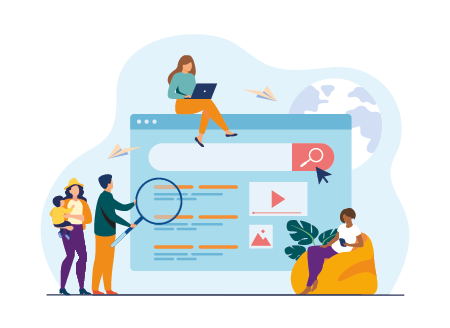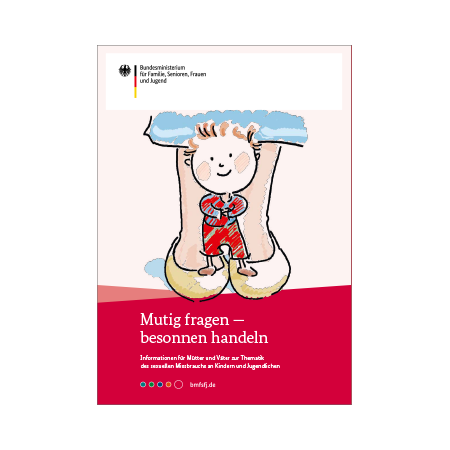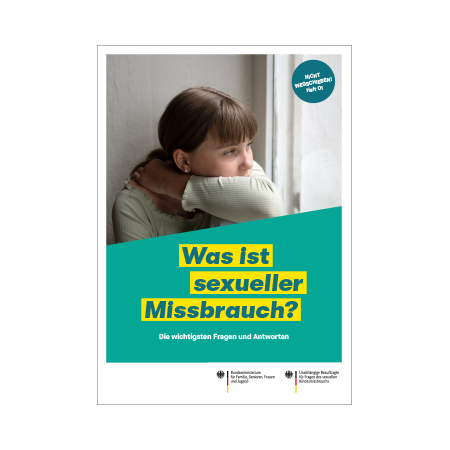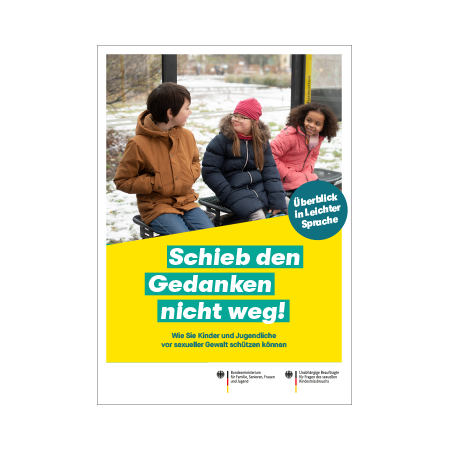Violence against children
Every child has the right to be protected from violence.
The child's right to respect, protection and support and to grow up free from violence is not yet taken into account across the board. Violence against children has many facets and happens in many places. For example, at home, at school, in clubs or on the playground. In addition to visible physical violence, there are many forms of invisible violence, such as psychological abuse and neglect. In the aftermath of violence, it makes no difference whether it is emotional or physical violence. The consequences of any violence are devastating and can have a life-long impact. Do not look away. Read what you can do to prevent violence in parenting and where to get help if a child is affected.
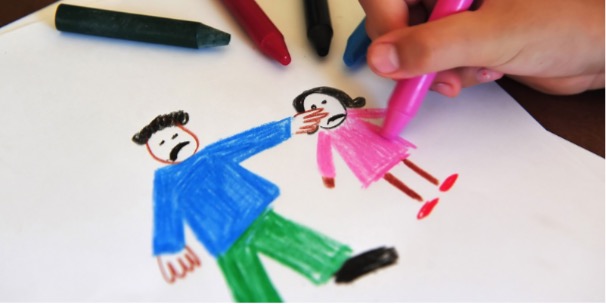
Look instead of looking away
Violence against children is a difficult topic for most people. It is often not easy to recognize indications that a child's welfare is at risk. The psychological and emotional forms of violence are also often more difficult to recognize. It often happens where we least suspect it: At home, at the sports club, at school or in our own environment. Most often, violence against children takes place in the family - in an environment where children should actually experience protection and safety.
Take the initiative if you suspect that something is wrong or the situation is escalating repeatedly. And get help if your child or another child in your environment is affected. You can get unbureaucratic and free support from the state's advice centers.
The forms of violence against children are diverse
Violence against children can look very different. Awareness of physical and sexual violence against children is usually more pronounced than that of psychological violence or child neglect. These forms of violence are difficult to recognize. Yet they are no less serious and have equally serious consequences for a child's future life. Affected children often do not speak out because they blame themselves, feel ashamed or are afraid of the perpetrators. Violence is therefore not easy to detect, especially in young children. Conspicuous behavior can be a sign that a child's welfare is at risk. The different forms of violence cannot be fundamentally separated from one another. For example, physical violence always has aspects of psychological violence.
-
Physical violence
Physical violence against children is a form of child abuse that refers to the deliberate use of physical force against a child. This form of violence can take different forms, such as hitting, kicking, shaking, biting or burning. Physical violence towards children has serious and long-term effects on the child's physical and psychological well-being and development. It can lead to injury, physical pain and even death. In addition, physical violence can also cause children to develop anxiety, depression and behavioral disorders. If you or someone you know is physically abusing a child or notices signs of physical abuse in a child, it is important to seek help immediately.
-
Mental abuse/psychological violence
Mental abuse or emotional abuse is a form of child maltreatment in which a child is repeatedly attacked, threatened, manipulated or controlled emotionally or with words. It can manifest itself in various ways, such as constant criticism, humiliation, intimidation, rejection or neglect. Mental abuse can have serious and long-term effects on a child's mental health and well-being. It can make children feel inferior and worthless, suffer from depression, anxiety and other mental health issues, or have difficulty forming healthy relationships.
-
Child neglect/emotional neglect
Emotional neglect is a form of child abuse in which a child does not receive the necessary emotional support, care and attention from their caregivers. It refers to a situation where a child feels abandoned, unwanted or unloved and is unable to connect with their caregivers. This can happen in different ways, such as ignoring or rejecting children, a lack of communication or togetherness, or a lack of physical touch and hugs. Emotional neglect can lead to serious long-term effects on a child's physical, mental and emotional health. Children who are emotionally neglected can struggle to develop healthy relationships, confidence and positive self-esteem. They may also be at higher risk for depression, anxiety and other mental health disorders.
-
Sexualized violence/sexual abuse
Sexualized violence against children occurs when an adult performs sexual acts on or in front of a child. It can start with lewd comments and "grabbing" and go all the way to the use of massive physical violence. The child is either forced or is too young to show their own boundaries. Additional pressure is often exerted through threats, blackmail or violence. Sexual abuse is always an abuse of power. The adult uses the child for their own sexual needs. They alone are responsible for their actions.
How can violence against children be recognized?
Violence against children can manifest itself in different ways, from physical violence to emotional or sexual violence. Here are some possible signs of violence against children:
- Physical injuries: Children who are physically abused may have visible injuries such as bruises, cuts, burns or broken bones.
- Behavioral changes: Children who are victims of violence may show behavioral changes such as aggression, withdrawal, anxiety or depression.
- Avoidance of certain people or places: Children who are victims of violence may try to avoid certain people or places associated with the violence.
- Sexualized behavior: Children who are sexually abused may show behavioral changes, such as aggressive behavior or an unpleasant interest in sexuality.
- Neglect: Neglect is a form of violence against children in which a child's needs are not adequately met. Signs of neglect can include inadequate nutrition, poor hygiene, poor health or poor school performance.
Please note: All the signs and behavioral abnormalities of physical and psychological violence described here can also have other causes. This makes it all the more important to speak to the child if you suspect something. This is the only way to give them a chance to build trust, open up and get help.
Health consequences of violence against children
Violence against children has serious health consequences, both in the short and long term. Children who are victims of violence often suffer from physical and psychological pain, which can affect their physical and mental health.
Here are some of the health consequences of violence on children:
- Physical injuries: Children who experience physical violence may suffer physical injuries, such as bruises, cuts, broken bones or burns. These injuries can be acute and chronic and cause long-term damage.
- Mental health: Violence against children can have long-term effects on mental health, such as anxiety, depression, post-traumatic stress disorder and behavioral disorders.
- Developmental disorders: Children who are victims of violence may exhibit developmental disorders, such as delays in language development, learning disorders, etc.
Do you have a suspicion? How to react correctly
Many people feel helpless and overwhelmed when they perceive or observe violence against children. However, everyone is called upon to take a stand to protect children. Because violence against children is not a private matter! If your child is exposed to violence or you suspect that another child may be experiencing violence, you should definitely take action to prevent further harm.
It is important that you act with caution and do not rush into anything. Here's what you can do:
- Take the child's stories and suggestions seriously. "I believe you" is an important phrase to express empathy! Your sensitivity is needed so that the child can build trust. Show understanding, but remain reserved and do not ask probing questions.
- "Keep calm" is the most important message. If your own child is affected by violence, this can trigger strong feelings. Seek professional help quickly to discuss the next steps. There are many counseling services with experienced professionals that you can take advantage of free of charge. You can find practical help at the counseling centers of the youth welfare offices, educational counseling, the child protection association, churches and, of course, the police.
- If the violence takes place at home, physical separation may be useful.
- Your child probably needs support to deal with the violence. Contact one of the contact points listed below. You will receive specific advice from the experienced professionals.
- Filing a complaint is an important step. However, it can be useful to plan your plan with the specialists at the advice center. Not least to ensure the safety of the child.
- If you are also affected by violence, there are options for taking the child to a safe place. Here, too, the advice centers of the youth welfare offices, educational counseling, women's and men's counseling centers, the child protection association, churches and, of course, the police can help.
- It is important for parents who cannot control themselves, are overwhelmed or cannot find time for their child to seek support. With professional guidance, you can develop your parenting skills and find new ways of working with your child. The same applies in this case: get professional support from trained experts.
Who advises you and what you can expect
Pedagogically and psychologically trained specialists from various disciplines work in the counseling centers. The counselors are familiar with the topic and can plan important next steps with you.
Counseling sessions are free of charge and confidential. Telephone consultations are anonymous on request. You do not have to give your name.
You can tell the counselors about your suspicions, fears or knowledge and they will then ask more detailed questions so that a help plan can be developed.
You will discuss all further steps together. Possible consequences, such as taking the child to a safe place quickly, initiating help or other measures, will be agreed with you. It may be necessary to involve the police or the youth welfare office. The advice center will also support you in this. The aim is always to act in the interests of the child's safety.
Interview with Christa Kortenbrede on the topic of protection against sexualized violence against children and young people
We spoke to Christa Kortenbrede about warning signs and the process of an initial consultation at the advice centre.
Where can we find help and advice?
There are many support and advice services for families in North Rhine-Westphalia. The Familienlotse of the Familienportal.NRW makes it easier to search and find your way around. It helps you to quickly and easily find the right offer near your place of residence.
You can also call or get help online here:
If there is imminent danger and you need help quickly, it is best to contact the police directly. You can find police advice centers in your area via the police website: www.polizei-beratung.de
You can find advice services from the Child Protection Association online or on the phone at www.kinderschutz-in-nrw.de
If you fear sexual assault, you can call the "Sexual Abuse" help line free of charge and anonymously on 0800 22 55 530. Further information is available on the homepage: www-help-telephone-abuse.online
The online services offered by the educational counseling centers range from group chats and mail counseling to individual chats: www.eltern.bke-beratung.de.


